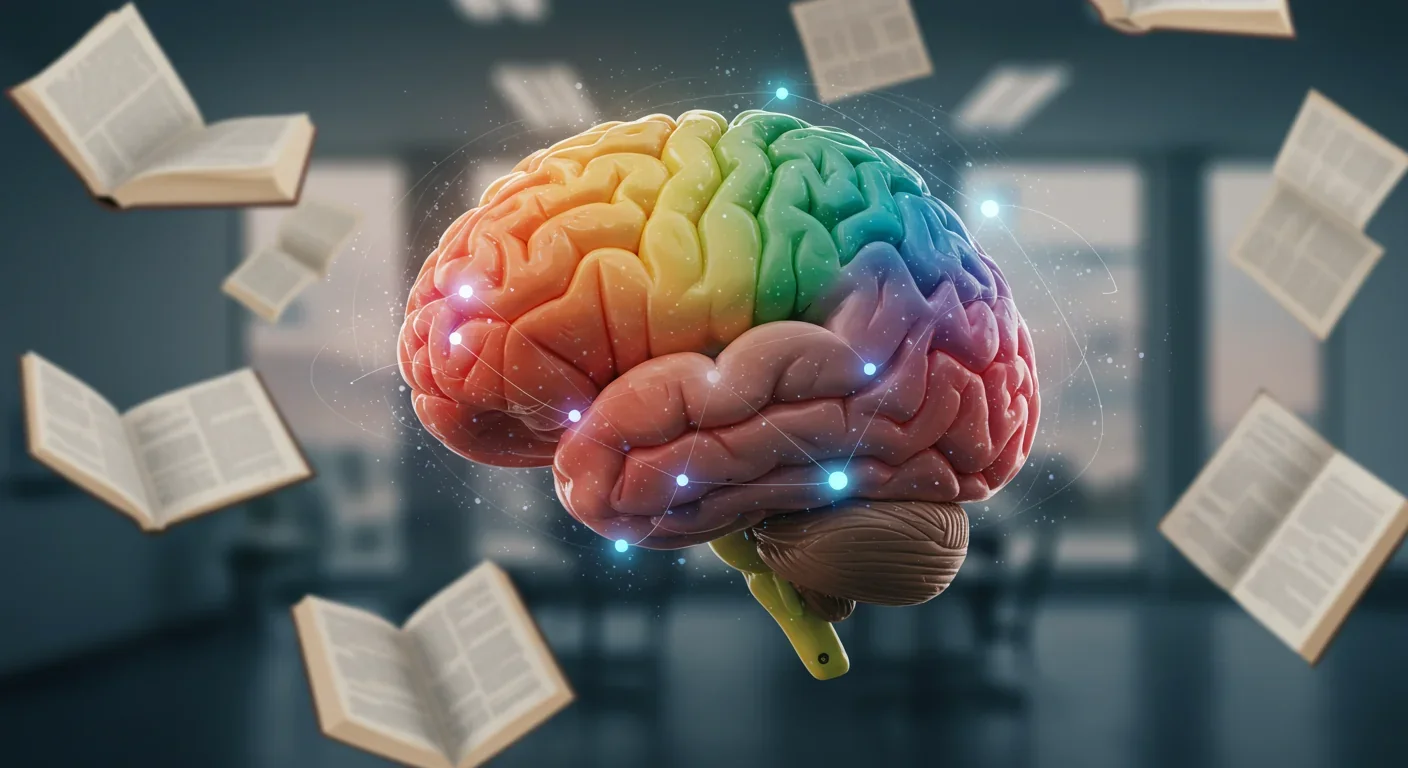Why Your Brain Sees Gods and Ghosts in Random Events

TL;DR: Stories hijack your brain through neural coupling, mirror neurons, and framing effects—making narratives 22 times more memorable than facts and the key to influence in work and life.

Picture this: you're scrolling through social media, half-distracted, when a post begins, "I'll never forget the day everything changed..." Suddenly, you stop. Your thumb hovers. You're hooked. That's not an accident—it's neuroscience at work. Stories hijack your brain in ways that facts never could, and understanding this mechanism might be the most powerful skill you can develop in a world drowning in information.
When someone tells you a story, something extraordinary happens in your skull. Research shows that stories don't just engage language centers—they activate sensory regions too. Neuroscientists call this neural coupling. Describe a delicious meal in a story, and your brain's taste and smell areas light up almost as if you were eating it yourself.
But here's where it gets really interesting. A recent study using hidden Markov modeling of fMRI data revealed that brief narrative priming completely reshapes brain state dynamics during story comprehension. When participants listened to the same ambiguous story under different narrative contexts—one framed as an affair, another as paranoia—their brains recruited entirely different networks. Control, salience, and visual networks fired differently based purely on how the story was introduced.
Think about that for a second. The story didn't change. Only the frame did. Yet participants' brains processed the exact same words through completely different neural pathways.
This isn't just fascinating science—it's the mechanism behind every persuasive pitch, every political campaign, and every brand that's ever made you feel something. When you read about someone else's struggles, your brain releases oxytocin, the same hormone that fosters trust and bonding. You're not just understanding their experience—you're living it, at least neurologically.
Here's an experiment: which do you remember better?
Version A: "Employee engagement increased by 23% after implementing the new program."
Version B: "Sarah had given up. Three years in the same role, watching colleagues get promoted while she felt invisible. Then her manager started asking different questions—not about metrics, but about her dreams. Within six months, she'd launched two initiatives that transformed her department."
If you're like most people, Version B just created a little movie in your head. Version A? Already fading.
Studies consistently show people are more likely to remember and act on information presented as a story rather than bullet points. The reason connects directly to how memory works. Your brain evolved to remember narratives because, for most of human history, stories were how we transmitted survival information. "Don't eat the red berries" is useful. "My cousin ate the red berries and spent three days hallucinating before nearly dying" ensures the lesson sticks for generations.
Research on e-commerce live streaming demonstrates this principle in modern contexts. When sellers embedded products in narratives—telling stories about how items fit into their lives—purchase intention increased significantly compared to straightforward product descriptions. The mechanism? Narrative transportation—that feeling of being "lost in a story" that temporarily overrides critical evaluation.
Your brain isn't just receiving information during a story; it's simulating experiences. When someone describes walking through snow, your motor cortex activates as if you're taking those steps. This multisensory simulation creates stronger, more durable memory traces than abstract facts ever could.

In the 1990s, Italian neuroscientists studying macaque monkeys stumbled onto something remarkable. They discovered neurons that fired both when a monkey performed an action and when it merely observed the same action. These mirror neurons weren't just recording what happened—they were internally recreating it.
In humans, this mirroring system is far more sophisticated. When we see someone in pain, our brains activate the same regions as if we were experiencing that pain ourselves. This neural architecture explains why you wince when someone on screen gets injured, and why even digital characters can make you feel genuine emotions.
What's even more fascinating? Empathy isn't a fixed trait—it's a trainable skill. Modern neuroscience reveals that empathy has four distinct components—cognitive perspective-taking, shared affect, empathic accuracy, and empathic motivation—and each can be strengthened through practice. This matters because the ability to craft stories that trigger empathic responses becomes a learnable competency, not an innate gift.
For leaders, this insight is transformative. In an AI-augmented world where pattern recognition is automated, the ability to tell stories that create genuine human connection becomes a sustainable competitive advantage that technology cannot replicate. The leader who can frame a strategic vision as a compelling narrative activates their team's mirror neurons, creating alignment not through logic alone but through shared emotional experience.
You're a doctor. You present two treatment options to a patient:
Option A: "This surgery has a 90% survival rate."
Option B: "This surgery has a 10% mortality rate."
Rationally, these statements are identical. But studies on decision-making show that people respond very differently depending on whether information is framed in terms of gains or losses. Option A sounds reassuring; Option B triggers fear.
This is the framing effect in action, and it reveals an uncomfortable truth: the story you tell about facts matters more than the facts themselves. Context doesn't just color interpretation—it fundamentally alters what your brain considers important.
Marketing professionals figured this out decades ago. But the implications extend far beyond commerce. Political campaigns frame the same policy as either "protecting freedom" or "endangering public health." Job candidates frame employment gaps as either "periods of unemployment" or "time invested in skill development and family." The underlying reality is identical—only the narrative changes.
Here's what makes this particularly powerful: once someone accepts a frame, contradictory information gets filtered out. Your brain doesn't neutrally evaluate new data—it runs it through the existing narrative structure. If the story you've already bought into says "this company is innovative," you'll interpret product delays as "perfectionism." If your story says "this company is disorganized," the same delays become proof of incompetence.
The person who controls the frame controls the decision. This is why storytelling isn't just useful communication—it's a fundamental lever of influence.
Stories didn't evolve because they're entertaining. They evolved because they're essential social technology. For thousands of years, storytelling served as the primary mechanism for transmitting cultural values, survival strategies, and social norms. Before writing, before institutions, before any formal education system, humans used stories to maintain social cohesion and pass knowledge across generations.
Every civilization developed story structures that reinforced its values. The hero's journey—found in myths from ancient Mesopotamia to modern Hollywood—teaches that transformation requires facing challenges. Tragedy teaches that hubris leads to downfall. Comedy teaches that rigid social structures deserve mockery. These aren't just entertainment formats; they're ethical instruction embedded in narrative form.
Research on narrative medicine demonstrates this principle in healthcare contexts. When physicians practice narrative competence—truly listening to patient stories rather than just extracting symptoms—diagnostic accuracy improves and patient satisfaction increases. The stories people tell about their illnesses contain crucial information that checklists miss.
In the digital age, storytelling hasn't diminished—it's multiplied across new platforms. A study on artist-facilitated storytelling programs showed that even brief narrative interventions can strengthen community bonds and individual wellbeing. Stories remain the most efficient way to transmit complex ideas in emotionally resonant formats.
But here's the catch: as algorithms learn to craft narratives optimized for engagement, we're entering an era where the stories that spread fastest aren't necessarily the ones that are true or beneficial. They're the ones that trigger the strongest neural responses. Understanding how stories work becomes critical not just for using them, but for defending against manipulation.

Knowing the science is one thing. Applying it is another. Here's what the research suggests actually works:
Start with sensory detail. Don't say "the grass is green." Say "the grass shimmered in the morning sun, damp with dew that clung like tiny jewels to each blade." That sensory specificity makes your brain light up instead of processing the information as mere data.
Master the frame before you present the content. McKinsey research on decision-making shows that leaders often dive into solutions before establishing the right frame. If you're pitching a project, don't start with features—start with the problem story that makes the solution inevitable.
Trigger empathy deliberately. Since empathy components can be trained, practice cognitive perspective-taking by explicitly imagining your audience's situation before you craft your message. What keeps them awake at night? What do they secretly fear? Your story should speak directly to those emotional undercurrents.
Use story structure to organize information. Whether you're choosing the hero's journey, tragedy, comedy, or another archetype, structure provides cognitive scaffolding that helps audiences follow complex ideas. A good structure is invisible—it just makes everything feel clear and inevitable.
Test your framing. Present the same information with different frames to small groups and watch for response patterns. "We're going to revolutionize the industry" hits differently than "We're going to solve a problem that's plagued this industry for twenty years." Same goal, different neural pathways activated.
Your brain has a Default Mode Network (DMN) that constantly narrates your life. This internal storyteller doesn't passively record—it actively constructs narratives about who you are and what everything means.
When you replay a conversation, your DMN isn't faithfully recording. It's writing a story, and that story becomes your reality. The narrative you tell yourself about yourself determines which opportunities you see, which risks you take, and how you interpret both success and failure. The good news? Like any narrative, it can be rewritten.
Not all stories work. Some fail spectacularly, and understanding why matters as much as understanding what works.
Over-complication. The brain can handle complex ideas, but only when delivered through simple narrative structures. When brands try to tell too many stories simultaneously, audiences tune out. One clear through-line beats multiple competing narratives every time.
Lack of authenticity. Your neural coupling mechanisms are exquisitely sensitive to emotional authenticity. When storytellers fake emotion or force enthusiasm, audiences detect the incongruence even if they can't articulate why something feels off.
Ignoring the audience's existing frame. If someone already has a strong narrative about a topic, your story needs to either align with that frame or explicitly acknowledge and reframe it. Simply presenting contradictory information doesn't work because the brain filters new data through existing narratives.
Forgetting the emotional arc. Research on narrative transportation shows that engagement requires emotional variation—tension and release, problems and solutions, setbacks and breakthroughs. Flat emotional landscapes, regardless of how interesting the content, fail to maintain attention.
As artificial intelligence gets better at generating text, video, and immersive experiences, the landscape of storytelling is shifting. AI can already craft narratives optimized for specific emotional responses, raising profound questions about authenticity and manipulation.
But here's the paradox: as synthetic stories proliferate, authentic human storytelling becomes more valuable, not less. In a world where AI excels at pattern recognition but cannot replicate genuine emotional depth, the ability to tell stories that create real connection becomes a uniquely human superpower.
The future belongs to those who understand both the science and the art—who can craft narratives that activate the right neural pathways while remaining grounded in authentic human experience. The question isn't whether stories will continue to shape perception, decision-making, and culture. They will. The question is whether you'll master this ancient technology for the modern age.
Your brain is wired for stories. It always has been. Now you know why—and what to do about it.

Recent breakthroughs in fusion technology—including 351,000-gauss magnetic fields, AI-driven plasma diagnostics, and net energy gain at the National Ignition Facility—are transforming fusion propulsion from science fiction to engineering frontier. Scientists now have a realistic pathway to accelerate spacecraft to 10% of light speed, enabling a 43-year journey to Alpha Centauri. While challenges remain in miniaturization, neutron management, and sustained operation, the physics barriers have ...

Epigenetic clocks measure DNA methylation patterns to calculate biological age, which predicts disease risk up to 30 years before symptoms appear. Landmark studies show that accelerated epigenetic aging forecasts cardiovascular disease, diabetes, and neurodegeneration with remarkable accuracy. Lifestyle interventions—Mediterranean diet, structured exercise, quality sleep, stress management—can measurably reverse biological aging, reducing epigenetic age by 1-2 years within months. Commercial ...

Data centers consumed 415 terawatt-hours of electricity in 2024 and will nearly double that by 2030, driven by AI's insatiable energy appetite. Despite tech giants' renewable pledges, actual emissions are up to 662% higher than reported due to accounting loopholes. A digital pollution tax—similar to Europe's carbon border tariff—could finally force the industry to invest in efficiency technologies like liquid cooling, waste heat recovery, and time-matched renewable power, transforming volunta...

Humans are hardwired to see invisible agents—gods, ghosts, conspiracies—thanks to the Hyperactive Agency Detection Device (HADD), an evolutionary survival mechanism that favored false alarms over fatal misses. This cognitive bias, rooted in brain regions like the temporoparietal junction and medial prefrontal cortex, generates religious beliefs, animistic worldviews, and conspiracy theories across all cultures. Understanding HADD doesn't eliminate belief, but it helps us recognize when our pa...

The bombardier beetle has perfected a chemical defense system that human engineers are still trying to replicate: a two-chamber micro-combustion engine that mixes hydroquinone and hydrogen peroxide to create explosive 100°C sprays at up to 500 pulses per second, aimed with 270-degree precision. This tiny insect's biochemical marvel is inspiring revolutionary technologies in aerospace propulsion, pharmaceutical delivery, and fire suppression. By 2030, beetle-inspired systems could position sat...

The U.S. faces a catastrophic care worker shortage driven by poverty-level wages, overwhelming burnout, and systemic undervaluation. With 99% of nursing homes hiring and 9.7 million openings projected by 2034, the crisis threatens patient safety, family stability, and economic productivity. Evidence-based solutions—wage reforms, streamlined training, technology integration, and policy enforcement—exist and work, but require sustained political will and cultural recognition that caregiving is ...

Every major AI model was trained on copyrighted text scraped without permission, triggering billion-dollar lawsuits and forcing a reckoning between innovation and creator rights. The future depends on finding balance between transformative AI development and fair compensation for the people whose work fuels it.